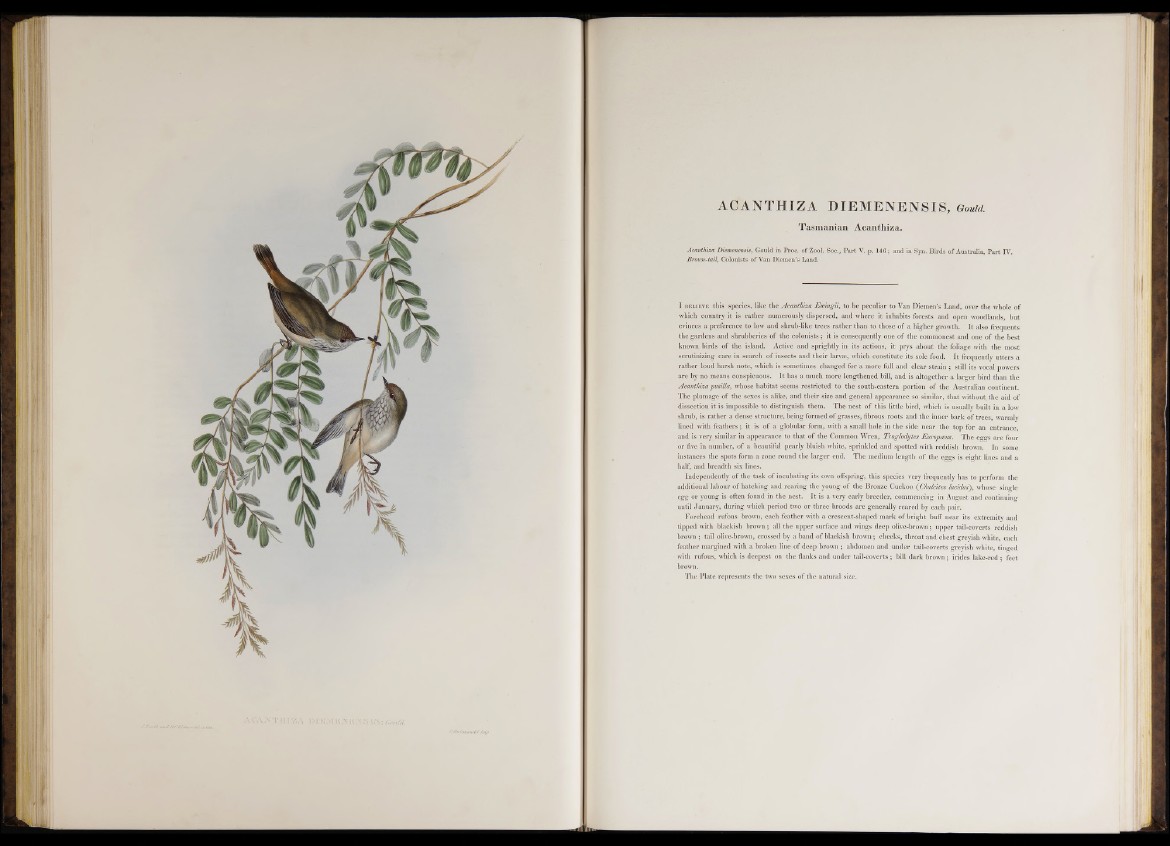
ACANTHIZA DIEMENENSIS, Gould.
Tasmanian Acanthiza.
Acanihiza Diemenensis. Gould in Proc. of ZooL Soc., Part V. p. 146 ; and in Syn. Birds of Australia, Part IV.
Brown-tail, Colonists of Van Diemen’s Land.
I b e l i e v e this species, like the Acanthiza Ewingii, to be peculiar to Van Diemen’s Land, over the whole of
which country it is rather numerously dispersed, and where it inhabits forests and open woodlands, but
evinces a preference to low and shrub-like trees rather than to those of a higher growth. It also frequents
the gardens and shrubberies of the colonists; it is consequently one o f the commonest and one o f the best
known birds o f the island. Active and sprightly in its actions, it prys about the foliage with the most
scrutinizing care in search o f iusects and their larvae, which constitute its sole food. It frequently utters a
rather loud harsh note, which is sometimes changed for a more full and clear strain ; still its vocal powers
are by no means conspicuous. It has a much more lengthened bill, and is altogether a larger bird than the
Acanthiza pusilla, whose habitat seems restricted to the south-eastern portion o f the Australian continent.
The plumage o f the sexes is alike, and their size and general appearance so similar, that without, the aid of
dissection it is impossible to distinguish them. The nest o f this little bird, which is usually built in a low
shrub, is rather a dense structure, being formed o f grasses, fibrous roots and the inner bark- of trees, warmly
lined with feathers; it is of a globular form, with a small hole in the side near the top for an entrance,
and is very similar in appearance to that o f the Common Wren, Troglodytes Europceus. The eggs are four
or five in number, o f a beautiful pearly bluish white, sprinkled and spotted with reddish brown. In some
instances the spots form a zone round the larger end. The medium length o f the eggs is eight lines and a
half, and breadth six lines.
Independently o f the task o f incubating its own offspring, this species very frequently has to perform the
additional labour o f hatching and rearing the young o f the Bronze Cuckoo ( Chalcites lucidus'), whose single
egg or young is often found in the nest. It is a very early breeder, commencing in August and continuing
until January, during which period two or three broods are generally reared by each pair.
Forehead rufous brown, each feather with a crescent-shaped mark o f bright buff near its extremity and
tipped with blackish brown; all the upper surface and wings deep olive-brown; upper tail-coverts reddish
brown ; tail olive-brown, crossed by a band of blackish brown; cheeks, throat and chest greyish white, each
feather margined with a broken line o f deep brown ; abdomen and under tail-coverts greyish white, tinged
with rufous, which is deepegt on the flanks and under tail-coverts ; bill dark brown; irides lake-red • feet
brown.
The Plate represents the two sexes o f the natural size.